If you’ve ever found yourself lost in the world of acoustic guitar strings, wondering which set is right for you, you’re not alone. Choosing the perfect strings can feel overwhelming, whether you’re seeking a change from your usual set or stepping into the world of acoustic guitar for the first time. With years of experience playing all kinds of acoustics, from travel-sized companions to rich-toned classical guitars, I’m here to guide you through selecting the Recommended Acoustic Guitar Strings that match your playing style and instrument.
The realm of guitar strings is deeply personal, and for me, gauge is the most critical factor when making a choice. While different brands may offer subtle variations in feel, the fundamental nature of a string remains consistent. Switching brands might bring minor differences, but altering the gauge will significantly impact your guitar’s playability and sound. For a deeper dive into string gauge and its effects, be sure to explore the FAQs section later in this article.
Another crucial consideration is whether to opt for coated or uncoated strings. These two types differ noticeably in both feel and sound. To my ears, coated strings possess a slightly mellower tone compared to their uncoated counterparts. However, for my gigging acoustic, coated strings are indispensable due to their extended lifespan. Conversely, for my home practice guitar or recording sessions, uncoated strings are my preference, as pristine sound quality takes precedence in those scenarios.
Navigating these choices can initially seem daunting, which is why many players tend to stick with familiar options. However, I wholeheartedly recommend acoustic guitar players to regularly experiment with new strings and different gauges across their guitars. This exploration can profoundly alter your instrument’s sound and playability, potentially reigniting your inspiration if you feel musically stagnant. Below, I’ve curated six of the best recommended acoustic guitar strings currently available, each uniquely suited to different playing needs. Let’s explore these top picks.
Top Recommended Acoustic Guitar Strings: Product Guide
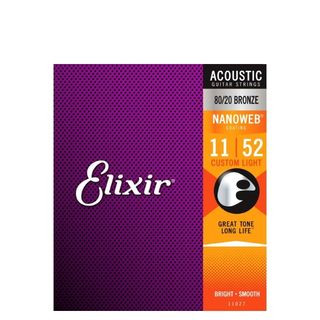 Best acoustic guitar strings: Elixir Nanoweb 80/20 Bronze
Best acoustic guitar strings: Elixir Nanoweb 80/20 Bronze
Best Overall
1. Elixir Nanoweb 80/20
Material: 80/20 Bronze
Coating: Nanoweb
Pros: Great sound, Long-lasting
Cons: Not cheap
Elixir Nanoweb 80/20 bronze strings are my go-to choice for all my gigging acoustic guitars. If longevity is your priority, these strings are hard to surpass. Regularly wiping them down after playing further extends their lifespan, making them a truly durable option.
While coated strings can sometimes feel unfamiliar if you’re accustomed to uncoated strings, Elixirs strike an excellent balance. Among all coated sets I’ve tested, they closely mimic the feel of traditional, uncoated strings.
The sound profile is slightly more subdued compared to some uncoated strings, but unless you’re recording with a high-sensitivity condenser microphone, this difference is unlikely to be noticeable. In fact, their slightly toned-down sound can be advantageous for acoustic guitars that tend to be overly bright. For consistent performance and extended life, Elixir Nanoweb 80/20 are highly recommended acoustic guitar strings.
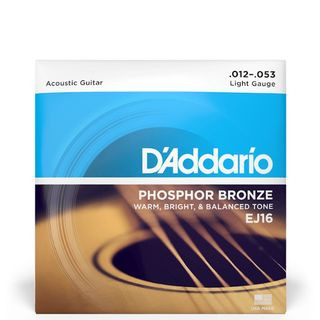 Best acoustic guitar strings: D’Addario EJ16
Best acoustic guitar strings: D’Addario EJ16
Best Beginner
2. D’Addario EJ16 Acoustic
Material: Phosphor Bronze
Coating: N/A
Pros: Value for money, Wide range of gauges
Cons: Not as long-lasting as coated strings
D’Addario EJ16 strings have been a staple in my guitar journey for years. In fact, they were the very first set of acoustic strings I ever purchased, back when pop-punk bands dominated the airwaves.
I continue to use EJ16s due to their exceptional combination of affordability and the extensive range of gauges available. This versatility makes them ideal for experimenting with different gauges on various acoustic guitars to optimize playability. For beginners exploring string gauges, these are highly recommended acoustic guitar strings.
Sonically, they deliver a fantastic, open voice to any acoustic guitar they adorn. The primary drawback is their uncoated nature, which means they won’t last as long as coated strings. However, given their budget-friendly price point, frequent string changes aren’t a significant concern for most players. For value and versatility, D’Addario EJ16 are excellent recommended acoustic guitar strings.
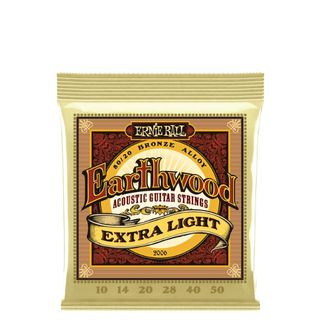 Best acoustic guitar strings: Ernie Ball Earthwood
Best acoustic guitar strings: Ernie Ball Earthwood
Best Budget
3. Ernie Ball Earthwood
Material: 80/20 Bronze
Coating: N/A
Pros: Super cheap, Balanced sound
Cons: Noticeable finger squeak
I’m a dedicated user of Ernie Ball electric guitar strings, particularly their renowned Slinky range. While Ernie Ball is a household name for electric strings, their acoustic offerings, like the Earthwood range, often fly under the radar.
Ernie Ball Earthwood strings are a fantastic, incredibly affordable option that punches above its weight. While they aren’t my primary strings, I wholeheartedly recommend acoustic guitar beginners to consider them as their first string set.
The overall sound quality is impressive, offering a balanced tone. However, I do find them to be slightly more prone to finger squeak compared to some other strings on this list. If you’re looking to experiment with various gauges without breaking the bank, Ernie Ball Earthwood strings are the perfect, budget-conscious choice and recommended acoustic guitar strings for exploration.
 A packet of Martin Retro acoustic guitar strings
A packet of Martin Retro acoustic guitar strings
Best Fingerpicking
4. Martin Retro
Material: Nickel Copper
Coating: N/A
Pros: Warm tone, Good value
Cons: Not the brightest tone
While no specific string set is mandatory for fingerpicking, I prefer strings that are slightly less bright and “clanky” for my fingerstyle acoustic guitars.
The Martin Retro set perfectly fits this preference, delivering a noticeably warmer tone right out of the package compared to standard sets. This warmer character stems from their unique nickel/copper wrap, differentiating them from other strings on this list and resulting in a more mellow sound. For fingerstyle players seeking warmth, these are highly recommended acoustic guitar strings.
I was pleasantly surprised by their longevity for uncoated strings. While the warmer tone might not appeal to everyone, I believe they are an excellent choice for fingerpickers seeking a richer, less piercing sound. For players prioritizing warmth and a vintage vibe, Martin Retro strings are highly recommended acoustic guitar strings.
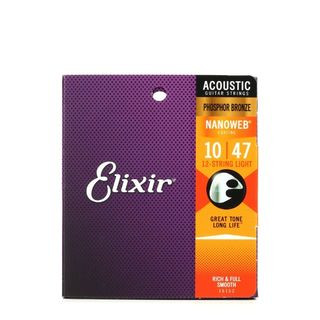 A pack of Elixir Nanoweb 12-string acoustic guitar strings
A pack of Elixir Nanoweb 12-string acoustic guitar strings
Best 12-String
5. Elixir 12-string
Material: Phosphor Bronze
Coating: Nanoweb
Pros: Beds in quickly, Long-lasting
Cons: Expensive
Restringing any guitar can be a chore, but doing it on a 12-string is particularly tedious. Although I currently own only one 12-string, I still dread every string change.
My primary reason for favoring Elixirs on my 12-string is the extended lifespan offered by their coated strings. They are a premium investment, but I gladly pay the price to minimize the frequency of 12-string restringing. For 12-string guitars, Elixir Nanoweb are strongly recommended acoustic guitar strings for convenience.
I also appreciate their sound on a 12-string. Excessive overtones can be particularly pronounced on 12-string guitars, but the Elixir coating subtly mutes them, resulting in a more controlled and balanced sound. They also settle in and stabilize their tuning much faster than regular, uncoated sets, which is a significant advantage for 12-string instruments. For 12-string players seeking longevity and balanced tone, Elixir 12-string Nanoweb are highly recommended acoustic guitar strings.
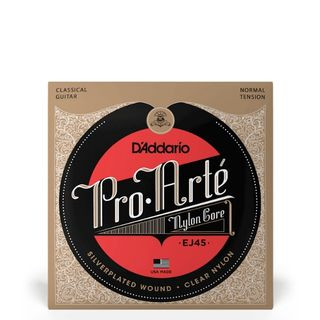 Best acoustic guitar strings: D’Addario EJ45 Pro-Arte
Best acoustic guitar strings: D’Addario EJ45 Pro-Arte
Best Nylon
6. D’Addario EJ45 Pro-Arte
Material: Nylon, Silver-Plated Copper
Coating: N/A
Pros: Warm sound, Balanced tension
Cons: Some players prefer high tension
If you’re restringing a classical guitar, D’Addario EJ45 Pro-Arte nylon guitar strings are among the best recommended acoustic guitar strings in the market. Two of my classical guitars are currently strung with these sets, and they consistently deliver exceptional performance.
D’Addario utilizes a multi-filament nylon core in their construction, which, in simpler terms, translates to consistent responsiveness and a warm, inviting tone. The treble strings are clear without being overly bright, facilitating a balanced sound, especially when fingerpicking. For classical guitars, D’Addario EJ45 Pro-Arte are highly recommended acoustic guitar strings.
I prefer the normal tension set, which provides a harmonious blend of playability and projection. Players seeking greater volume, particularly for purely acoustic performances, might prefer higher tension sets, which D’Addario also offers for classical guitars. For classical guitarists seeking a balanced and warm tone, D’Addario EJ45 Pro-Arte are highly recommended acoustic guitar strings.
FAQs About Acoustic Guitar Strings
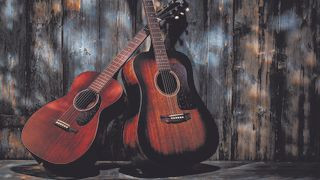 Two acoustic guitars on dark background
Two acoustic guitars on dark background
(Image credit: Future)
What is the best string gauge for acoustic guitars?
String gauge refers to a string’s thickness or diameter. A larger gauge indicates a thicker string. Gauge significantly influences a guitar’s playability and tone, and consequently, your playing style. Understanding gauge is key to choosing recommended acoustic guitar strings for your needs.
Guitar strings are measured in thousandths of an inch and are typically packaged in sets identified by the gauge of their thinnest string, the high E. For example, a “set of 12s” denotes a high E string with a 12-gauge thickness, measuring 0.012 inches in diameter.
Thicker strings generally produce a fuller sound. They tend to be louder than thinner strings and possess a rounded, bass-heavy low end. Their increased durability is a significant advantage. However, thicker gauges also present challenges.
If you’re still developing strength in your fretting hand, thicker gauges can make playing quite demanding, especially for techniques like string bending and fast runs. Conversely, if you’re a heavy-handed strummer or prefer down-tuning, thicker string gauges are well-suited to your playing style. Choosing the right gauge is crucial when considering recommended acoustic guitar strings.
Lighter gauge strings are easier to fret and bend, and they produce a brighter tone. The trade-off is a reduction in deep bottom-end frequencies. For some players, this brighter tone is a worthwhile compromise.
Consider your guitar’s body size. Smaller-bodied acoustic guitars might be better complemented by lighter gauge strings. Conversely, dreadnought or jumbo-sized acoustics might benefit from thicker strings. However, there are no rigid rules. Some players use heavier strings on smaller bodies to enhance depth and vice versa. Experimentation is key to finding your preference for recommended acoustic guitar strings gauge.
Which acoustic strings are best for beginners?
For beginner acoustic guitar players, selecting appropriate strings is crucial. You’ll want strings that balance playability and tone. Understanding string gauges and their impact on sound and playing experience is essential for beginners seeking recommended acoustic guitar strings.
Here are common generic acoustic guitar string gauges. Slight variations may exist between brands, and some brands offer hybrid sets, but this provides a useful general guide.
Extra light: .010 .014 .023 .030 .039 .047
Custom light: .011 .015 .023 .032 .042 .052
Light: .012 .016 .025 .032 .042 .054
Medium: .013 .017 .026 .035 .045 .056
Heavy: .014 .018 .027 .039 .049 .059
If you’re playing in standard tuning, Extra Light or Custom Light strings are recommended acoustic guitar strings for beginners. These are often referred to as “sets of 10s” or “sets of 11s.” They offer a bright, punchy tone with relatively low string tension, making them easier to play. As your comfort and hand strength increase, consider experimenting with heavier strings. However, excessively heavy strings are unnecessary unless your playing style specifically demands them.
Note that electric guitar string gauges are named differently. Avoid directly comparing acoustic and electric guitar gauges, as acoustic guitars generally require heavier strings to achieve their optimal sound. Starting with lighter gauges is generally recommended acoustic guitar strings advice for beginners.
When should I change my acoustic guitar strings?
The frequency of acoustic guitar string changes depends largely on your playing time. However, as a general guideline, restringing your acoustic guitar at least every couple of months is recommended acoustic guitar strings maintenance. This practice keeps your instrument sounding and feeling its best. Coated strings may offer extended life, but once your strings begin to sound or look dull, it’s time for a fresh set. Regular string changes are a vital part of guitar maintenance and ensure optimal tone.
What are acoustic guitar strings made of?
Acoustic guitar strings are commonly crafted from materials like bronze, phosphor bronze, brass, nickel, silk, and steel. Each material imparts a unique tonal characteristic. Understanding these materials helps in choosing recommended acoustic guitar strings for specific sounds.
Bronze strings produce a bright sound with bell-like clarity and a treble-focused frequency response. Phosphor bronze, as the name suggests, includes phosphor in the alloy to slow oxidation and prolong string life. Phosphor bronze strings typically sound slightly warmer and darker than pure bronze.
Brass strings offer a jangly top-end sparkle, while nickel strings provide a warmer, vintage-inspired tone. Monel, a nickel-based alloy, is also favored by many guitarists seeking to maximize their tonewood’s sonic potential. Material choice is a key factor when considering recommended acoustic guitar strings for tone.
Are nylon guitar strings easier to play?
In short, yes. Nylon guitar strings are categorized as having high or low tension. High-tension strings feel heavier, while low-tension strings are easier to play. Even “high” tension nylon strings have less tension than steel or bronze strings. This lower tension is a primary reason why many beginners start with nylon-string classical guitars. For beginners, nylon strings are often recommended acoustic guitar strings for ease of play.
In classical guitar sets, the top three strings are made of clear or rectified nylon. The bottom three strings typically consist of bronze or silver-plated copper wire wrapped around a multi-filament core. Nylon strings (sometimes called “classical” strings) are exclusively for classical guitars. It’s crucial not to confuse nylon and steel strings. The significant difference in string tension means that using steel strings on a classical guitar can cause serious damage to the instrument. Always ensure you are using the correctly recommended acoustic guitar strings type for your guitar.
How We Recommend Acoustic Guitar Strings
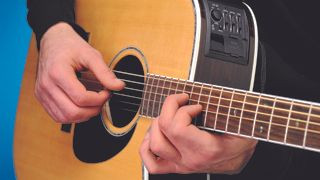 Man plays chord on acoustic guitar
Man plays chord on acoustic guitar
(Image credit: Future)
When evaluating acoustic guitar strings to provide recommended acoustic guitar strings, a thorough and time-intensive testing process is essential.
I begin by stringing up my acoustic guitar with a fresh set and observing how long they take to “bed in” or settle. This assesses how quickly the strings fully stretch and stabilize in tune. The best string sets achieve this within a few hours, requiring minimal playing before reaching tuning stability.
Next, I evaluate the string feel under my fingers. I look for smooth strings free of imperfections that could hinder playing. For coated strings, ideally, the coating should be imperceptible. While coated strings invariably feel slightly different from uncoated ones, the goal is a comfortable playing experience.
Corrosion is a primary reason for string replacement. To assess string lifespan, I leave the strings on my guitar for an extended period, noting when discoloration, tarnish, or loss of tonal brilliance becomes apparent. Longevity is a key factor in recommended acoustic guitar strings.
Throughout the testing phase, I meticulously listen to the strings’ sound across various playing styles, songs, and environments. I pay close attention to their sonic response and how they evolve over time. Sound quality is paramount in recommended acoustic guitar strings assessments.
With years of experience listening to diverse acoustic guitars and string sets, my evaluations are grounded in extensive knowledge. Ultimately, sound preference is subjective. I acknowledge that what sounds appealing to my ears may differ for other musicians. However, this rigorous testing process ensures that the recommended acoustic guitar strings are evaluated comprehensively for a wide range of players and preferences.
Read more about how we test music-making gear and services at MusicRadar.

